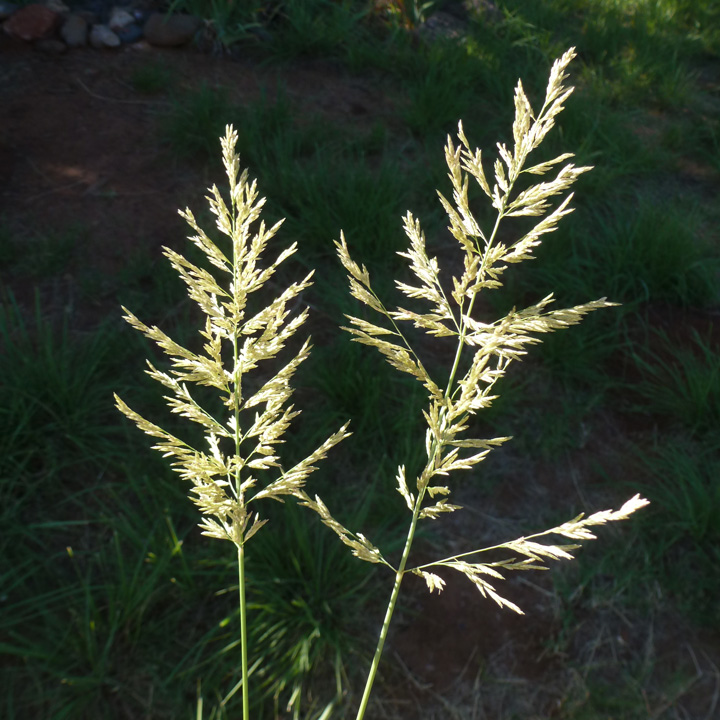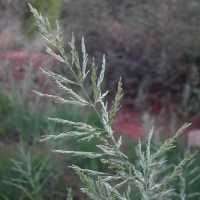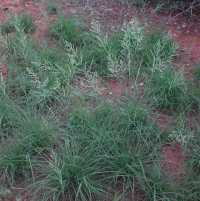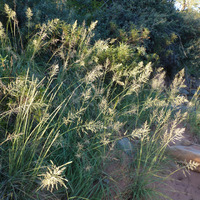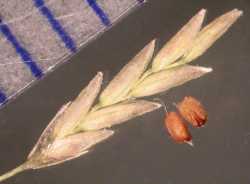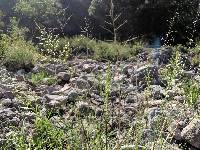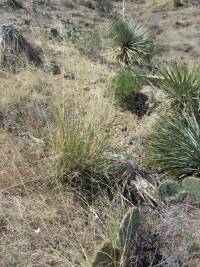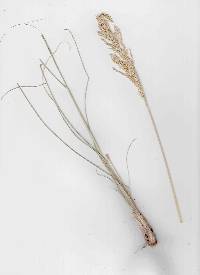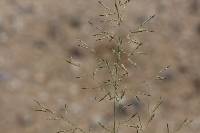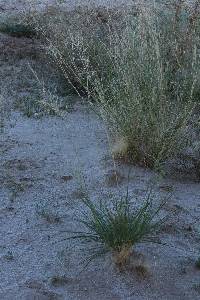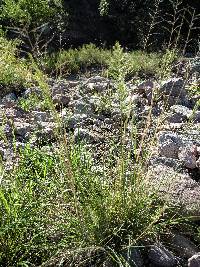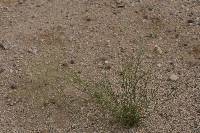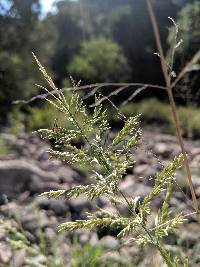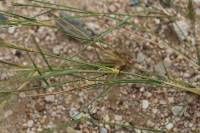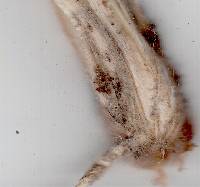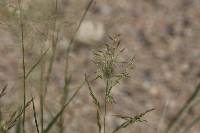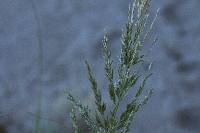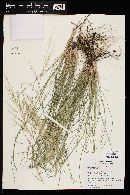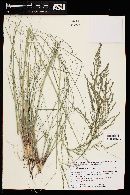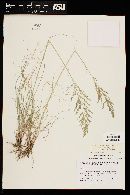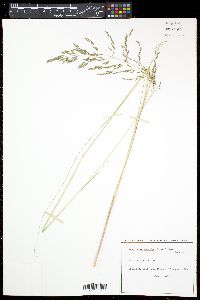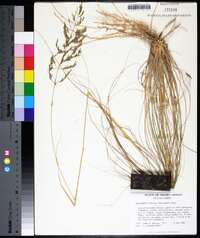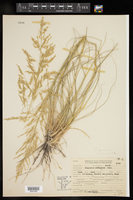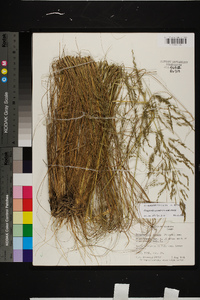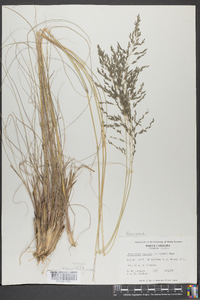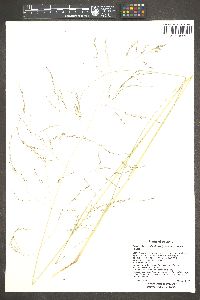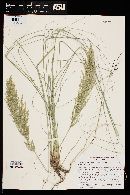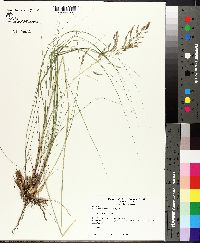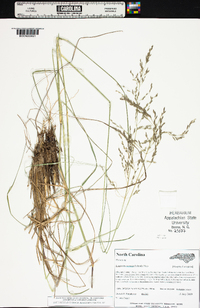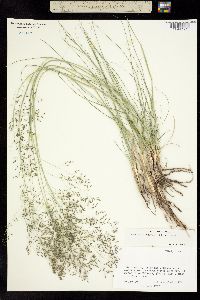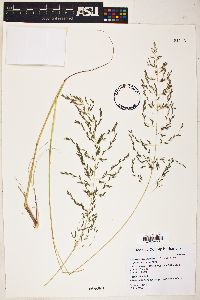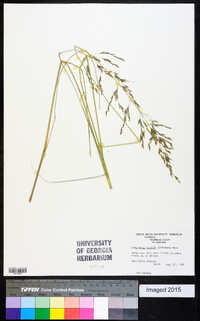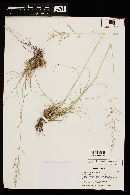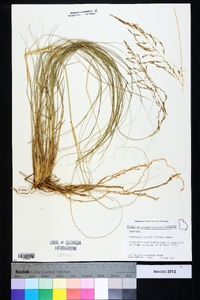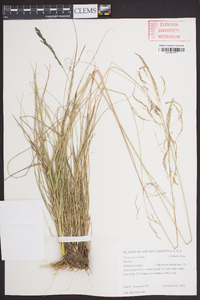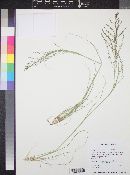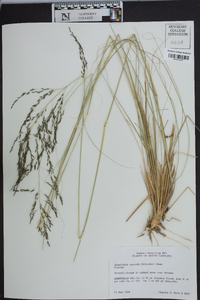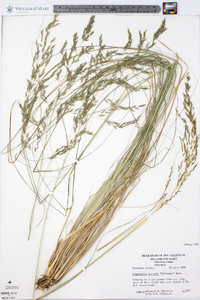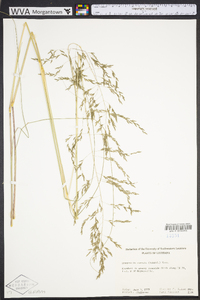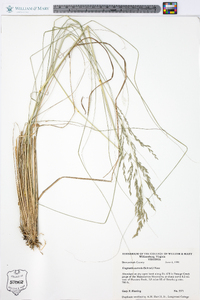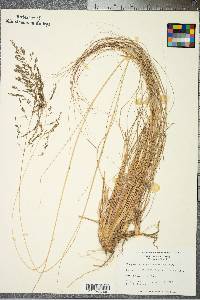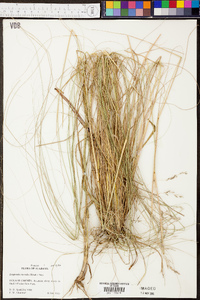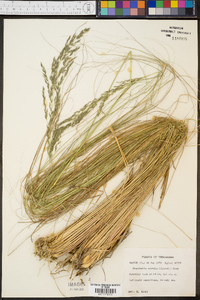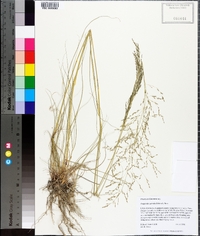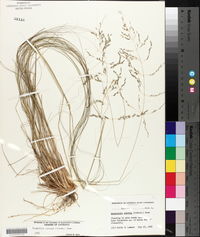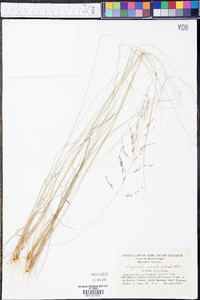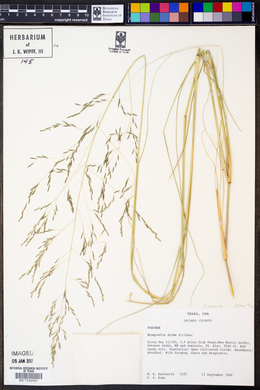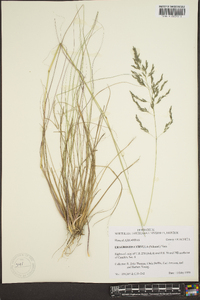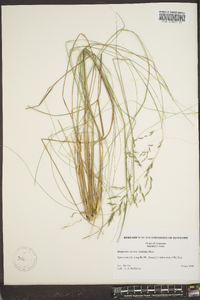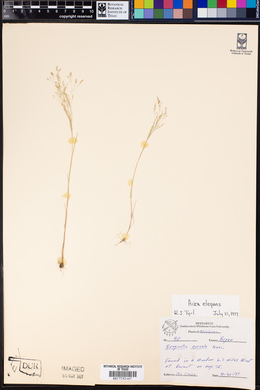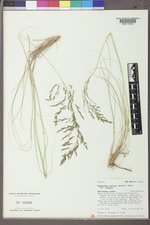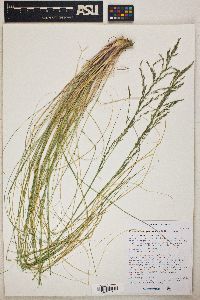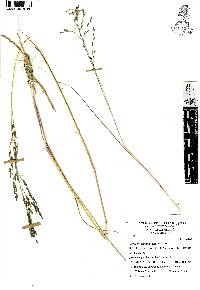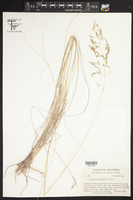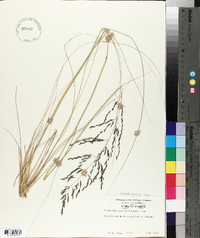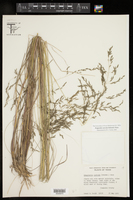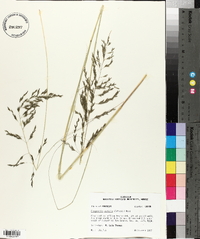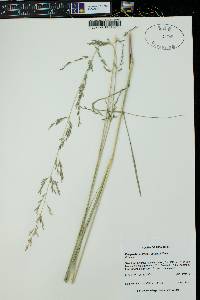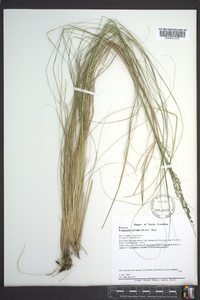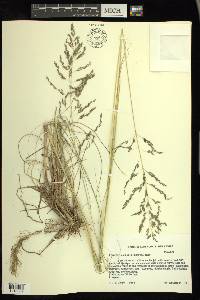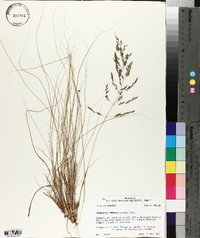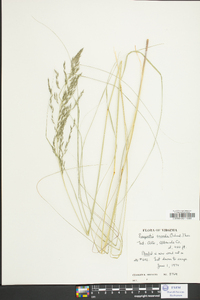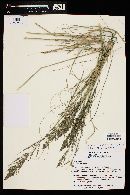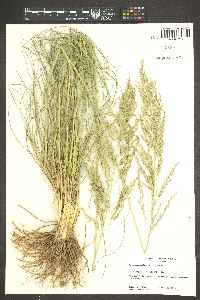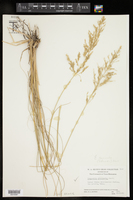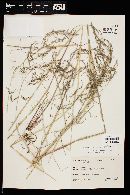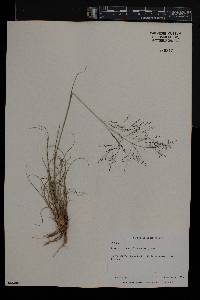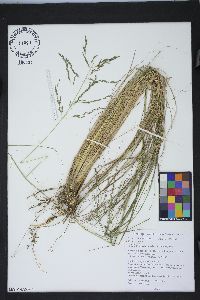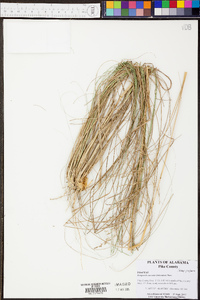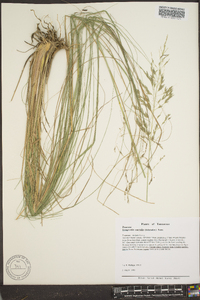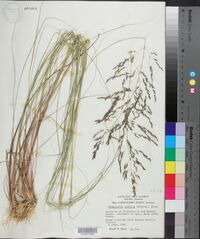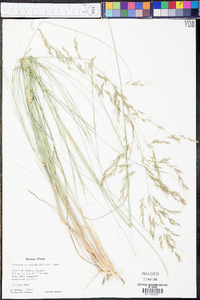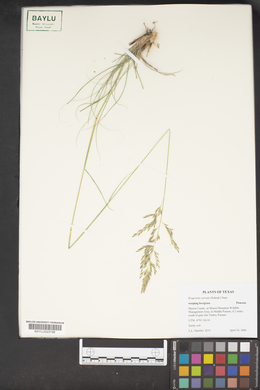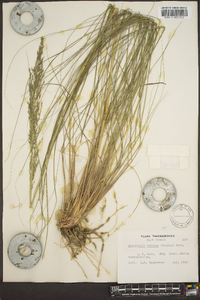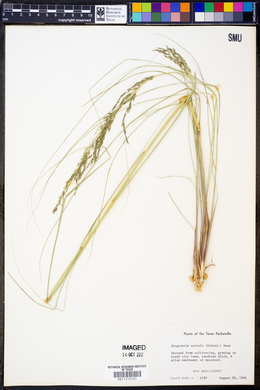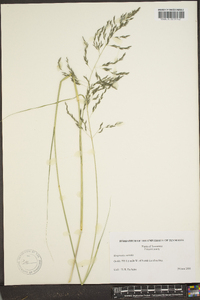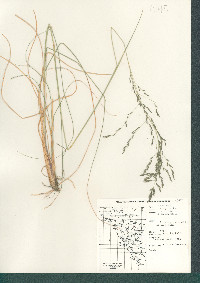
|
|
|
|
Family: Poaceae
Weeping Love Grass, more...weeping lovegrass (es: zacate de amor llorón, amor seco curvado)
[Eragrostis chloromelas Steud., moreEragrostis curvula var. atrata (Schweinf.) Cufod., Eragrostis curvula var. conferta Stapf, Eragrostis curvula var. curvula , Eragrostis curvula var. valida Stapf, Eragrostis robusta Stent, Eragrostis thunbergiana var. atrata Schweinf., Poa curvula Schrad.] |
Plants perennial; cespitose, forming innovations at the basal nodes, without glands. Culms (45)60-150 cm, erect, glabrous or glandular. Sheaths with scattered hairs, hairs to 9 mm; ligules 0.6-1.3 mm; blades 12-50(65) cm long, 1-3 mm wide, flat to involute, abaxial surfaces glabrous, sometimes scabridulous, adaxial surfaces with scattered hairs basally, hairs to 7 mm. Panicles 16-35(40) cm long, (4)8-24 cm wide, ovate to oblong, open; primary branches 3-14 cm, diverging 10-80° from the rachises; pulvini glabrous or not; pedicels 0.5-5 mm, appressed, flexible. Spikelets 4-8.2(10) mm long, 1.2-2 mm wide, linear-lanceolate, plumbeous to yellowish, with 3-10 florets; disarticulation irregular to acropetal, proximal rachilla internodes persistent. Glumes lanceolate, hyaline; lower glumes 1.2-2.6 mm; upper glumes 2-3 mm; lemmas 1.8-3 mm, ovate, membranous, lateral veins conspicuous, apices acute; paleas 1.8-3 mm, hyaline to membranous, apices obtuse; anthers 3, 0.6-1.2 mm, reddish-brown. Caryopses 1-1.7 mm, ellipsoid to obovoid, dorsally compressed, adaxial surfaces with a shallow, broad groove or ungrooved, smooth, mostly translucent, light brown, bases often greenish. 2n = 40, 50. Eragrostis curvula is native to southern Africa. It is often used for reclamation because it provides good ground cover but, once introduced, it easily escapes. In the Flora region, it grows on rocky slopes, at the margins of woods, along roadsides, and in waste ground, at 20-2400 m, usually in pine-oak woodlands, and yellow pine and mixed hardwood forests. Dr. David Bogler, USDA NRCS PLANTS Database Perennials, Terrestrial, not aquatic, Stems nodes swollen or brittle, Stems erect or ascending, Stems caespitose, tufted, or clustered, Stems terete, round in cross section, or polygonal, Stem internodes solid or spongy, Stem internodes hollow, Stems with inflorescence less than 1 m tall, Stems with inflorescence 1-2 m tall, Stems, culms, or scapes exceeding basal leaves, Leaves mostly basal, below middle of stem, Leaf tips flexuous, drooping, blades thin, lax, soft, Leaves sheathing at base, Leaf sheath mostly o pen, or loose, Leaf sheath hairy, hispid or prickly, Leaf sheath hairy at summit, throat, or collar, Leaf sheath and blade differentiated, Leaf sheath indurate basally, Leaf blades linear, Leaf blades very narrow or filiform, less than 2 mm wide, Leaf blades 2-10 mm wide, Leaf blades mostly flat, Leaf blade margins folded, involute, or conduplicate, Leaf blades mostly glabrous, Ligule present, Ligule a fringe of hairs, Inflorescence terminal, Inflorescence an open panicle, openly paniculate, branches spreading, Inflorescence a contracted panicle, narrowly paniculate, branches appressed or ascending, Inflorescence solitary, with 1 spike, fascicle, glomerule, head, or cluster per stem or culm, Inflorescence lax, widely spreading, branches drooping, pendulous, Inflorescence curved, twisted or nodding, Inflorescence branches more than 10 to numerous, Flowers bisexual, Spikelets pedicellate, Spikelets laterally compressed, Spikelet less than 3 mm wide, Spikelets with 3-7 florets , Spikelets with 8-40 florets, Spikelets solitary at rachis nodes, Spikelets all alike and fertille, Spikelets bisexual, Spikelets disarticulating above the glumes, glumes persistent, Spikelets disarticulating beneath or between the florets, Rachilla or pedicel glabrous, Glumes present, empty bracts, Glumes 2 clearly present, Glumes equal or subequal, Glumes distinctly unequal, Glumes shorter than adjacent lemma, Glumes 1 nerved, Lemmas thin, chartaceous, hyaline, cartilaginous, or membranous, Lemma similar in texture to glumes, Lemma 3 nerved, Lemma glabrous, Lemma apex truncate, rounded, or obtuse, Lemma apex acute or acuminate, Lemma awnless, Lemma margins thin, lying flat, Lemma straight, Palea present, well developed, Palea membranous, hyaline, Palea shorter than lemma, Palea 2 nerved or 2 keeled, Palea keels winged, scabrous, or ciliate, Stamens 3, Styles 2-fid, deeply 2-branched, Stigmas 2, Fruit - caryopsis, Caryopsis ellipsoid, longitudinally grooved, hilum long-lin ea FNA 2003, Gould 1980 Common Name: weeping lovegrass Duration: Perennial Nativity: Non-Native Lifeform: Graminoid General: Tufted perennial, stems erect or ascending, 75-150 cm tall. Vegetative: Sheaths shorter than internodes, open, keeled, lower ones hispid; basal sheaths numerous and spread out, densely villous on back and less so on margins, upper glabrous; ligule ciliate, truncate, about 1 mm long; blades involute, setaceous, flexuous, usual Inflorescence: Panicles oblong or ovoid, open, 25-40 cm long, 8-12 cm wide, rachis scabrous, flexuous, 8-15 cm long; lower axils densely pubescent, upper less so; spikelets oblong-lanceolate, 6-12 flowered, 4-10 mm long, compressed, grayish-green, rachilla disarticulating; glumes acuminate, lanceolate, compressed, keeled, first 2 mm long, second 3 mm long; lemmas narrowly ovate, acute, lateral nerves conspicuous; caryopsis ellipsoidal, striate, 1.5 mm. Ecology: Found on sandy soils, roadsides, in burns and grasslands; 7,000 ft (2134 m); flowers June-August. Distribution: Native to Africa and naturalized in many of the tropical and temperate regions of the world; N. Amer. in WA, OR and most of the southern half of the US from CA to NY; south through MEX into S. Amer. Notes: Eragrostis species have branched inflorescences (panicles), multiple, bisexual flowers (florets) per spikelet and components of the spikelets are for the most part hairless and awnless. E. curvula is a perennial bunchgrass typically more robust and taller than the other regional Eragrostis species. It is distinguished by having an erect habit with a height to 1.5 m, leaf blades 12-65 cm long, pedicels and spikelets which are appressed to the panicle branches, and a linear-lanceolate spikelet 4-10 mm long and 1.5-2 mm wide. The panicle appears more dense than other perennial Eragrostis in the region; primary panicle branches are ascending-spreading away from the main axis and well-spaced along the axis, but each branch is fairly crowded with appressed spikelets from the branch tips nearly to the base. The species was introduced from Africa and used as a reseeding grass in the early 20th century along with E. lehmanniana. Ethnobotany: Unknown Etymology: Eragrostis is from Greek eros, love and agrostis, grass, while curvula refers to its curved habit. Synonyms: Eragrostis chloromelas, E. curvula var. conferta, E. curvula var. curvula, E. robusta Editor: SBuckley 2010, FSCoburn 2014, AHazelton 2015 Erect, tufted perennial 6-18 dm; sheaths keeled and ±hispidulous basally; lvs firm, involute, narrow, arcuate-ascending, tapering to a fine point; infl 2-3.5 dm, pilose in the main axils, elongate and open but scarcely diffuse, the pedicels short and ±appressed to the branchlets; spikelets leaden-gray, 5-9 mm, 5-9(-11)-fld, the lemmas individually deciduous or more persistent and the rachilla fragmenting; first glume 1.5-2(2.5) mm, the second 2-2.8 mm; lemmas 2-3 mm, evidently 3-veined; 2n=20, 40, 60. Native of S. Afr., cult. for forage or ornament and escaped at scattered stations as far n. as N.J. and Pa. (where becoming common). Gleason, Henry A. & Cronquist, Arthur J. 1991. Manual of vascular plants of northeastern United States and adjacent Canada. lxxv + 910 pp. ©The New York Botanical Garden. All rights reserved. Used by permission. |
|
|
|

